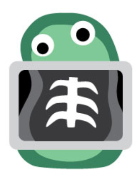Team:BYU Provo/Project
From 2011.igem.org
(Prototype team page) |
Cheddar3210 (Talk | contribs) |
||
| (34 intermediate revisions not shown) | |||
| Line 1: | Line 1: | ||
| - | < | + | {{Template:BYU_Provo}} |
| + | <div id='pageContents'> | ||
| + | <html><script> | ||
| + | var ele = document.getElementById('liProject'); | ||
| + | ele.style.fontWeight = "bold"; | ||
| + | ele.style.backgroundColor = "#059469"; | ||
| + | </script></html> | ||
| - | + | ==The Problem== | |
| - | + | [[File:X ray E.png|right|X-Ray]] | |
| - | + | The [http://www.cancer.org/Cancer/ColonandRectumCancer/DetailedGuide/colorectal-cancer-key-statistics American Cancer Society] has found that 1 in 20 Americans will have colorectal cancer. While current screening methods have led to a decrease in fatalities, the Society estimates another 50,000 people will die from colorectal cancers this year alone. As the disease progresses, it becomes [http://www.cancer.org/Cancer/ColonandRectumCancer/DetailedGuide/colorectal-cancer-survival-rates harder to successfully treat], making early detection important. Regular non-invasive screening could save tens of thousands of lives each year in the United States alone. | |
| - | + | ||
| - | + | ||
| - | + | ||
| - | + | ||
| - | + | ||
| - | + | ||
| - | + | ||
| - | + | ||
| - | + | ||
| - | + | ||
| - | |||
| - | + | ===A Bioengineered Solution?=== | |
| - | + | [[File:Doctor E.png|left|The Doctor]]We think that E. coli could be engineered using simple interchangeable parts to act as an effective biosensor for colorectal cancer. | |
| - | + | ||
| - | + | ||
| - | + | ||
| - | + | ||
| - | + | ||
| - | + | ||
| - | + | ||
| - | + | ||
| - | + | ||
| - | + | ===Dual-Input 'AND' Gate=== | |
| + | We learned from the literature that polyps in the colon and rectum frequently have higher temperatures and higher concentrations of reactive oxygen species (ROS) than normal tissue. While either of these could potentially serve as an input to our biosensor, it is the elevation of both heat and ROS that makes polyps so unique in the human body. We have devised a simple molecular [http://en.wikipedia.org/wiki/AND_gate 'AND' gate] such that only in the elevated presence of both inputs will our marker protein be translated. | ||
| - | + | Visit our [https://2011.igem.org/Team:BYU_Provo/Modeling Modeling Page] for more detailed information on the AND gate and how it works. | |
| - | + | ||
| - | + | ||
| - | + | ||
| - | + | ||
| - | + | ||
| - | + | ||
| - | + | ||
| - | + | ||
| - | + | ||
| - | + | ||
| + | ==The Simple Interchangeable Parts== | ||
| + | Please give the presentation thirty seconds to load after you press the 'play' button below. "Autoplay" can be selected under the "More" menu in the bottom right corner once the presentation is ready. Alternatively, the presentation is interactive and can be maneuvered with the mouse. | ||
| + | <html><div class="prezi-player"><style type="text/css" media="screen">.prezi-player { width: 550px; } .prezi-player-links { text-align: center; }</style><object id="prezi__eixeckh-lhj" name="prezi__eixeckh-lhj" classid="clsid:D27CDB6E-AE6D-11cf-96B8-444553540000" width="550" height="400"><param name="movie" value="http://prezi.com/bin/preziloader.swf"/><param name="allowfullscreen" value="true"/><param name="allowscriptaccess" value="always"/><param name="bgcolor" value="#ffffff"/><param name="flashvars" value="prezi_id=_eixeckh-lhj&lock_to_path=0&color=ffffff&autoplay=no&autohide_ctrls=0"/><embed id="preziEmbed__eixeckh-lhj" name="preziEmbed__eixeckh-lhj" src="http://prezi.com/bin/preziloader.swf" type="application/x-shockwave-flash" allowfullscreen="true" allowscriptaccess="always" width="550" height="400" bgcolor="#ffffff" flashvars="prezi_id=_eixeckh-lhj&lock_to_path=0&color=ffffff&autoplay=no&autohide_ctrls=0"></embed></object><div class="prezi-player-links"><p><a title="BYU iGEM Team 2011 E. Colinoscopy" href="http://prezi.com/_eixeckh-lhj/final-construct/">Final Construct</a> on <a href="http://prezi.com">Prezi</a></p></div></div></html> | ||
| - | + | </div> | |
| - | + | ||
| - | + | ||
| - | + | ||
| - | + | ||
| - | + | ||
| - | + | ||
| - | + | ||
| - | + | ||
| - | + | ||
| - | + | ||
| - | + | ||
| - | + | ||
| - | + | ||
| - | + | ||
| - | + | ||
| - | + | ||
| - | + | ||
| - | + | ||
| - | + | ||
| - | + | ||
| - | + | ||
| - | + | ||
| - | + | ||
| - | + | ||
| - | + | ||
| - | + | ||
| - | + | ||
| - | + | ||
| - | + | ||
| - | + | ||
| - | + | ||
| - | + | ||
| - | + | ||
| - | + | ||
Latest revision as of 19:57, 14 October 2011

|
Contents |
The Problem
The [http://www.cancer.org/Cancer/ColonandRectumCancer/DetailedGuide/colorectal-cancer-key-statistics American Cancer Society] has found that 1 in 20 Americans will have colorectal cancer. While current screening methods have led to a decrease in fatalities, the Society estimates another 50,000 people will die from colorectal cancers this year alone. As the disease progresses, it becomes [http://www.cancer.org/Cancer/ColonandRectumCancer/DetailedGuide/colorectal-cancer-survival-rates harder to successfully treat], making early detection important. Regular non-invasive screening could save tens of thousands of lives each year in the United States alone.
A Bioengineered Solution?
We think that E. coli could be engineered using simple interchangeable parts to act as an effective biosensor for colorectal cancer.Dual-Input 'AND' Gate
We learned from the literature that polyps in the colon and rectum frequently have higher temperatures and higher concentrations of reactive oxygen species (ROS) than normal tissue. While either of these could potentially serve as an input to our biosensor, it is the elevation of both heat and ROS that makes polyps so unique in the human body. We have devised a simple molecular [http://en.wikipedia.org/wiki/AND_gate 'AND' gate] such that only in the elevated presence of both inputs will our marker protein be translated.
Visit our Modeling Page for more detailed information on the AND gate and how it works.
The Simple Interchangeable Parts
Please give the presentation thirty seconds to load after you press the 'play' button below. "Autoplay" can be selected under the "More" menu in the bottom right corner once the presentation is ready. Alternatively, the presentation is interactive and can be maneuvered with the mouse.
 "
"

